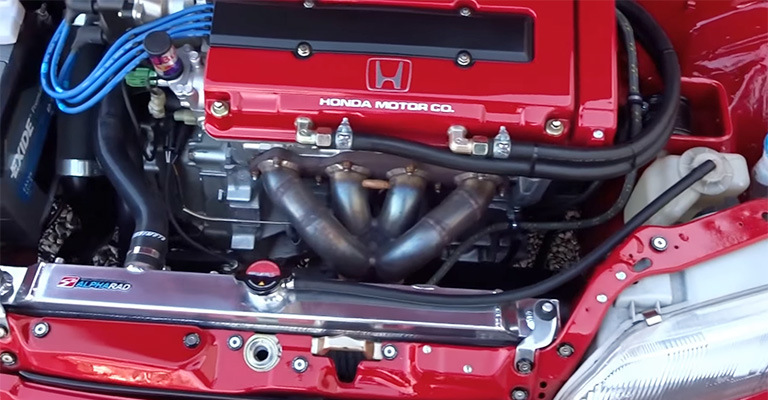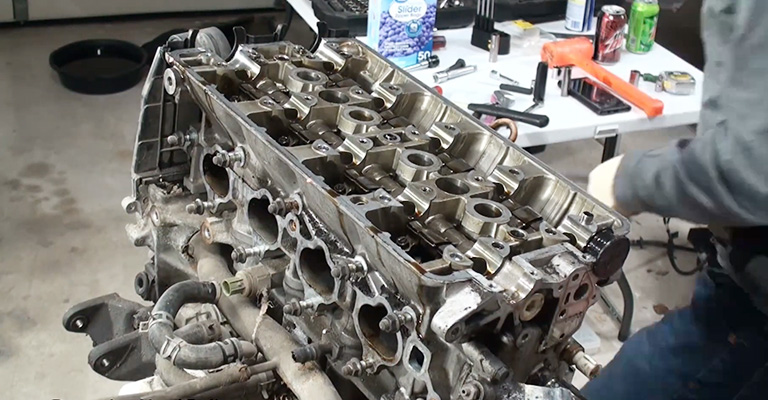The Honda B16A1 engine is a highly sought after power plant among car enthusiasts. It’s a 1.6-liter, DOHC VTEC engine that was produced in the late 80s and early 90s. With its impressive specs and performance capabilities,
the B16A1 is considered one of the most well-rounded engines Honda has ever produced. Understanding the specs and performance of an engine is crucial for car enthusiasts, as it provides insight into the potential and limitations of a vehicle.
In this blog post, we will dive into the specs and performance of the Honda B16A1 engine, giving car enthusiasts a comprehensive understanding of what makes this engine so special.

Honda B16A1 Engine Overview
The Honda B16A1 engine is a 1.6-liter, DOHC VTEC engine that was produced by Honda for their European market (EDM) vehicles. It was used in the Honda CRX 1.6 DOHC VTEC (EE8) and the Honda Civic 1.6 DOHC VTEC (EE9).
The engine was first introduced in the late 80s and was known for its high revving capabilities and impressive power output.
The B16A1 engine has a bore of 81mm and a stroke of 77.4mm, giving it a compression ratio of 10.2:1. This combination of specs allows the engine to produce 150 horsepower at 7600 RPM and 111 lb⋅ft of torque at 7100 RPM.
The engine is equipped with Honda’s VTEC (Variable Valve Timing and Lift Electronic Control) technology, which engages at 5200 RPM and provides a significant boost in power output.
The B16A1 engine has a high RPM redline of 8200 RPM, making it a popular choice for high-performance enthusiasts who like to push the limits of their vehicles.
The engine’s power and torque output at high RPM, along with its VTEC technology, give it a thrilling driving experience that is highly sought after.
Overall, the Honda B16A1 engine is considered one of the most well-rounded engines Honda has ever produced.
Its impressive specs and performance capabilities have made it a popular choice among car enthusiasts and continue to make it a highly sought-after engine today.

Specification table for B16A1 Engine
| Specification | Value |
| Engine | B16A1 |
| Displacement | 1.6 L (97.3 cu in) |
| Bore x Stroke | 81mm x 77.4mm |
| Compression Ratio | 10.2:1 |
| Power Output | 150 hp at 7600 RPM |
| Torque Output | 111 lb⋅ft at 7100 RPM |
| VTEC Engagement | 5200 RPM |
| Redline | 8200 RPM |
| Found in | Honda CRX 1.6 DOHC VTEC (EE8), Honda Civic 1.6 DOHC VTEC (EE9), European market (EDM) |
Source: Wikipedia
Comparison with other B16 family engine like B16A1 and B16A3
The B16A1 engine is a member of the B16 engine family produced by Honda. There are several variations of the B16 engine, including the B16A1 and B16A3. While they share similar design features and origins, each engine has unique characteristics that set it apart from the others.
Comparison between B16A1 and B16A3
| Specification | B16A1 | B16A3 |
| Displacement | 1.6 L (97.3 cu in) | 1.6 L (97.3 cu in) |
| Bore x Stroke | 81mm x 77.4mm | 81mm x 77.4mm |
| Compression Ratio | 10.2:1 | 9.0:1 |
| Power Output | 150 hp at 7600 RPM | 125 hp at 6200 RPM |
| Torque Output | 111 lb⋅ft at 7100 RPM | 106 lb⋅ft at 5000 RPM |
| VTEC Engagement | 5200 RPM | N/A |
As shown in the table, both the B16A1 and B16A3 engines have similar displacement and bore x stroke measurements. However, the B16A1 has a higher compression ratio, which results in more power output compared to the B16A3.
The B16A1 also has VTEC technology, which the B16A3 does not.
This allows the B16A1 to produce a significant increase in power output at high RPMs. The B16A3, on the other hand, has a more balanced power delivery, with its torque output being relatively high even at lower RPMs.
both the B16A1 and B16A3 engines are highly capable power plants that each have their own strengths and weaknesses. The B16A1 is well-suited for high-performance applications, while the B16A3 is more well-rounded and balanced, making it a great choice for a wide range of applications.
Head and Valvetrain Specs B16A1
The B16A1 engine features a DOHC (Double Overhead Camshaft) design, with four valves per cylinder. The head and valvetrain design of the B16A1 are key components that contribute to its impressive performance.
Head Specs
- Material: Aluminum
- Valve Size: 32mm intake / 27mm exhaust
- Valve Springs: Dual
Valvetrain Specs
- Rocker Arms: Roller-type
- Camshaft Type: DOHC
- Camshaft Lift: 9.3mm intake / 8.3mm exhaust
- Duration: 260° intake / 240° exhaust
The use of high-strength aluminum for the head and roller-type rocker arms helps to reduce friction and increase durability.
The DOHC design, combined with the large valve sizes and high lift camshafts, allows the engine to breathe efficiently and produce high power output. The dual valve springs also help to ensure stability at high RPMs.
Overall, the head and valvetrain design of the B16A1 engine are key factors that contribute to its impressive performance and make it a popular choice among car enthusiasts.
The Technologies Used in
The B16A1 engine features several technologies that enhance its performance and reliability. Some of the key technologies used in the B16A1 engine include:
1. VTEC (Variable Valve Timing and Lift Electronic Control)
This technology allows the engine to switch between high and low valve lift and duration modes depending on the engine RPM. This results in increased power output and improved fuel efficiency.
2. PGM-FI (Programmed Fuel Injection)
The B16A1 engine uses Honda’s PGM-FI fuel injection system, which provides precise control over fuel delivery and allows the engine to run efficiently and cleanly.
3. OBD0 (On-Board Diagnostics, Generation 0)
This system is used to monitor and diagnose engine performance and emissions. It helps to ensure that the engine is running optimally and helps to identify any issues that may arise.
4. Y2 Transmission
The B16A1 engine is paired with Honda’s Y2 transmission, which is a close-ratio manual transmission designed to handle the high power output of the engine.
These technologies, along with the high-strength aluminum head and valvetrain components, contribute to the B16A1 engine’s impressive performance and reliability, making it a popular choice among car enthusiasts.
Performance Review
The Honda B16A1 engine is renowned for its impressive performance and is a popular choice among car enthusiasts. With a displacement of 1.6 liters and a power output of 150 horsepower at 7600 RPM.
The B16A1 engine is capable of delivering brisk acceleration and high top speeds. The engine produces 111 lb-ft of torque at 7100 RPM, giving it plenty of low-end grunt.
The B16A1’s DOHC design, large valve sizes, and high lift camshafts allow it to breathe efficiently, producing high power output and smooth operation. The VTEC technology, PGM-FI fuel injection system, and Y2 transmission all work together to help the engine perform at its best.
The engine’s redline of 8200 RPM provides plenty of headroom for high-performance driving, and the VTEC engagement of 5200 RPM ensures that the engine produces maximum power when it’s needed.
The close-ratio Y2 transmission helps to keep the engine in its powerband and provides crisp, precise shifting.
In conclusion, the Honda B16A1 engine is a high-performance engine that delivers impressive performance and reliability. Its combination of DOHC design, VTEC technology, PGM-FI fuel injection, and close-ratio Y2 transmission make it a popular choice among car enthusiasts and provide a thrilling driving experience.
What Car Did the B16A1 Come in?
The Honda B16A1 engine was primarily found in the European market Honda CRX 1.6 DOHC VTEC (EE8) and Civic 1.6 DOHC VTEC (EE9). These compact and sporty vehicles were designed to deliver high-performance handling and quick acceleration.
The B16A1 engine, with its high-revving design and impressive power output, was a perfect match for these vehicles, providing a thrilling driving experience for car enthusiasts.
Honda B16A1 Engine Most Common Problems
There could be several reasons for the issues you’re experiencing with your b16a1 swap.
Here are a few possible causes:
- Incorrect TPS wiring.
- Incorrect O2 sensor wiring.
- Fuel injector issue (e.g. clogged or damaged).
- Fuel pressure issue.
- Ignition system issue.
- Clogged air intake system.
To diagnose the issue, you can start by checking the TPS and O2 sensor wiring to make sure they are connected correctly. You can also measure the voltage and resistance of the injectors to see if they are working properly.
Another way to check if the injectors are working is to perform a fuel pressure test. Additionally, you can inspect the air intake system to make sure there are no clogs.
Other B Series Engines-

Leave a Reply